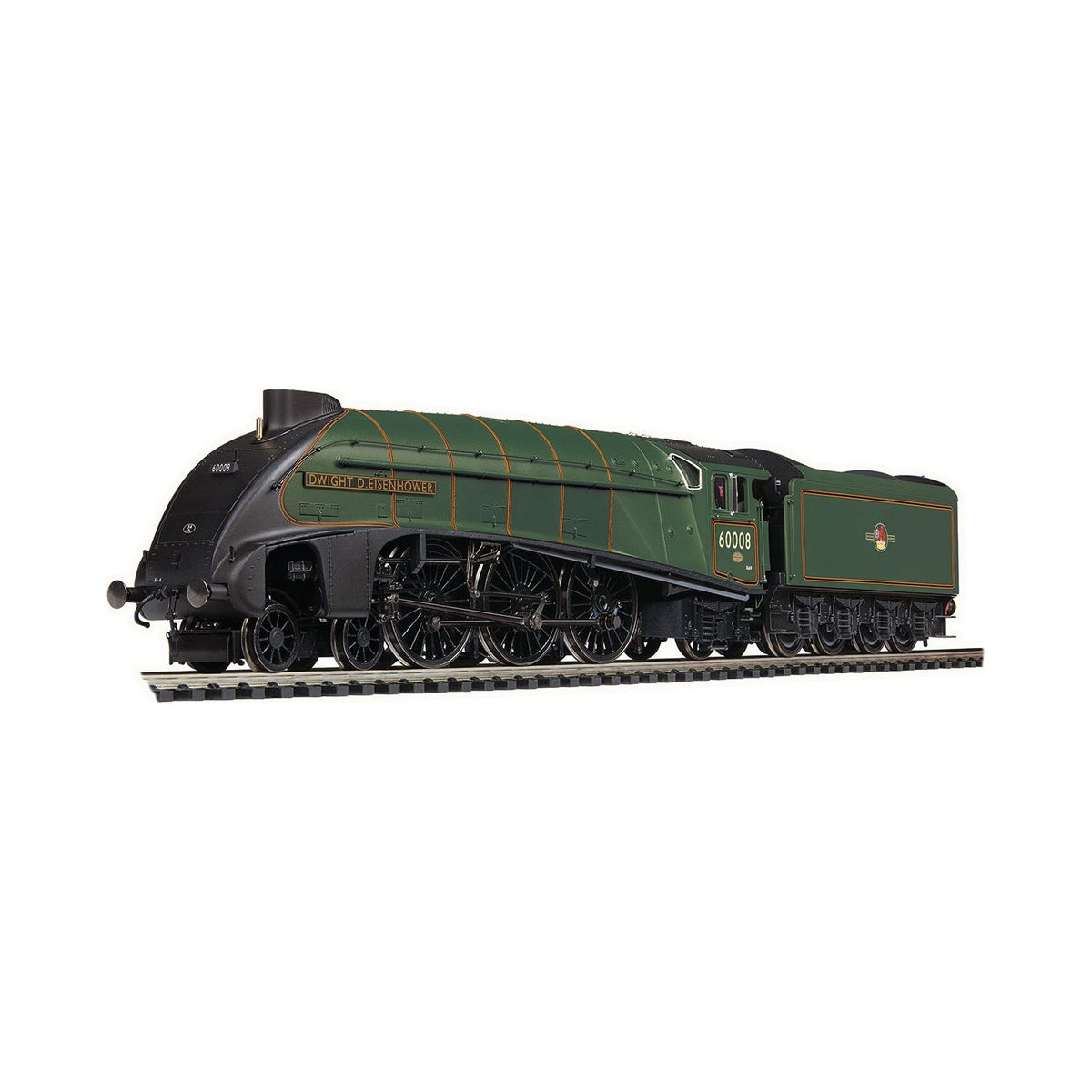HORNBY OO Dublo: BR, Class A4, 4-6-2, 60008 ‘Dwight D. Eisenhower’: Great Gathering 10th Anniversary – Era 10 HORNBY
$ 579,99 $ 174,00
HORNBY OO DUBLO: BR, CLASS A4, 4-6-2, 60008 ‘DWIGHT D. EISENHOWER’: GREAT GATHERING 10TH ANNIVERSARY – ERA 10
The LNER Gresley A4 is one of the most iconic express locomotives in Great Britain, with its streamlined casing a classic symbol of the attitude towards speed and design in the 1930s, which saw increased competition to the railways from road and air travel. The LNER Board knew that they had to make travel between the major cities faster, comfortable and more reliable.
Nigel Gresley, the LNER’s Chief Mechanical Officer, travelled on the Fliegende Hamburger diesel locomotive in Germany and was impressed by its streamlining, although he realized it was only efficient at high speeds. Gresley was certain that a modified A3 Pacific, with streamlining, could haul greater loads than other locomotives at the same speed or faster and a series of trials were conducted to confirm the A3’s suitability.
With the trials successfully completed, the LNER Board gave Gresley the go-ahead to create the “Silver Jubilee” streamlined trains, the first of the new streamlined A4s.The streamlining of the A4s’ steam circuit, higher boiler pressure and extension of the firebox to create a combustion chamber made them more efficient than the A3 as they consumed less coal and water- especially later on when they were also fitted with a Kylchap double chimney. This improved their free steaming capabilities further.
Their streamlined design not only made them capable of high speeds, but created an up draught of smoke, obscuring the driver’s vision, a major problem on the new Class A4 engines. The story goes that during wind tunnel testing, after several unsuccessful efforts to get the smoke to lift clear, a thumbprint was inadvertently left on the clay model just behind the chimney. This succeeded in clearing the smoke and was incorporated into the final design.
Dwight D. Eisenhower was introduced in 1937 as Golden Shuttle, only receiving the name Dwight D. Eisenhower in September of 1945 in homage to the then American Military Governor in Germany. The locomotive would go through the same protracted numbering rigmarole as all other LNER engines, initially being outshopped as 4496 before becoming locomotive number 8 in the 1946 LNER renumbering scheme.
Upon entry into BR service the locomotive would become engine number 60008. Following withdrawal in 1963, the locomotive was overhauled at Doncaster before being donated to the United States. In preservation, the locomotive has not steamed and has only ever been cosmetically restored, returning to the UK only once with sister engine Dominion of Canada as part of the Great Gathering in 2013.
Hornby Dublo A4 models feature a diecast body, just as their original Hornby Dublo counter parts would have been seen. This is coupled with enchanted decoration which when paired with the diecast of the boiler provides a realistic finish to the body. The models contain a 5 pole motor with flywheel and are DCC ready with an 8 pin socket. These models will also contain a detail bag containing etched nameplates and headboards, allowing the model to be displayed as it would have appeared at the Great Gathering.
Tech Specs
- Item Length – Without Packaging (cm)
- 29.1
- Item Height – Without Packaging (cm)
- 5
- Item Width – Without Packaging (cm)
- 3.5
- Item Weight – Without Packaging
- 0.6
- Item Scale
- 1:76 Scale 00 Gauge
- Finish
- Painted
- Colour
- Green
- Gauge
- OO
- DCC Status
- DCC Ready 8 pin socket
- Operator
- LNER
- Designer
- Sir Nigel Gresley
- Wheel Configuration
- 4-6-2
- Livery
- BR Lined Green
- Minimum Curve (mm)
- Radius 2
- Motor
- 5 Pole Skew wound
- Number of Parts
- 1
- Class
- A4 Class
- Buffer Type
- Sprung Metal Buffers
- Coupling Type
- NEM Tension Lock
- Hornby Decoder Compatibility Primary
- HM7000-8TXS: Bluetooth® & DCC Sound Decoder (8-pin)
Quick Shipping and Professional Packaging
Due to our long-term partnership in a long-standing partnership with UPS, FedEx, DHL and many other leading global carriers, we are able to offer an array of shipping options. Our warehouse staff are highly trained and will pack your products according to our precise and precise specifications. Your items will undergo a thorough inspection and be securely secured prior to being delivered. We ship to thousands clients each day across multiple countries. This is an indication of our dedication to being the biggest online retailer in the world. The warehouses are located in Europe as much as they are in the USA.
Note: Orders that include more than one item are assigned a processing time in accordance with the item.
Prior to shipment before shipping, we'll inspect thoroughly the items you've ordered. The majority of orders are shipped within 48 hrs. The time to deliver varies from 3-7 days.
Returns
We don't manage the stock in our warehouse and factory. Stocks are subject to change at any moment. You may not receive your order after the order has been made.
Our policy is for 30 days. If you have passed 30 days by since your purchase, unfortunately we can't offer you a refund or exchange.
The item cannot be used and in its original condition. It should also be in the original packaging.
Related products
RADIO CONTROL
RADIO CONTROL
RADIO CONTROL
RADIO CONTROL
RADIO CONTROL
RADIO CONTROL
RADIO CONTROL
RADIO CONTROL
RADIO CONTROL
(Clearance Item) HB RACING 5 Cell Main Chassis 2.5mm with Battery Tray (Cyclone) HB RACING
RADIO CONTROL
RADIO CONTROL
RADIO CONTROL
RADIO CONTROL
RADIO CONTROL


































